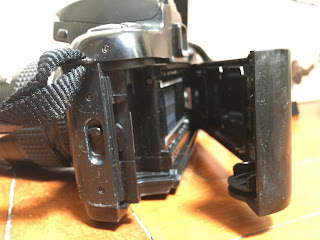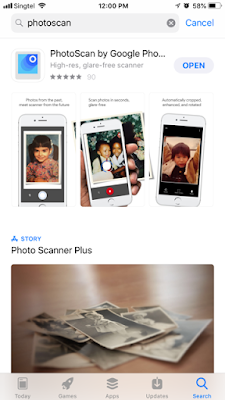This camera, in fact, my wife's and this was what she used during her teens. Yes, we are the generation that transited from film to digital and as much as I missed the nostalgic feeling of film, my wallet never looked back or at least recently after I found cheaper methods to enjoy film.
I choose to use a 'budget' ISO200 film to test this camera because I didn't want to waste a more expensive ISO 400 speed film and I wasn't sure if it is still working and wasn't sure what DX ISO coding the camera can accept. I couldn't find the manual for this, but a similar camera, the Zoom300AF could only do 100, 200, 400 and 1000. So, ISO 200, it is.
The Nikon Zoom200AF and all it needs to get up and running: CR123 battery and a nice 35mm film
First Look
Build quality wise, the Zoom200AF is a camera is not too heavy but it doesn't feel like a toy. The plastic used here reminds me of the type of plastic used for electrical plugs. Pretty heavy duty stuff, I might say.
How it looks like inside
Design wise, the Nikon Zoom200AF has lots of smooth curves. It was a departure from the older, boxy camera designs and it probably fit the bill and budget of what a family camera should be and it wouldn't be out of place in the hands of an elderly or a teenager.
I liked the way it feels in my hands. The curvy design is ergonomic and helps to place my fingers where they should be. For example, the left hand grip area is made deliberately to separate the flash from my fingers while providing a little grip for supporting the camera. The right hand grip area allows my palm to cup the camera snugly.
Fully extended lens at 70mm focal length
The Zoom200AF, as it implies, has an auto focus 2x zoom lens that starts from a wide 38mm to a short telephoto of 70mm. The focal length is typical of most zoom cameras and is a fairly versatile range. Although I would discourage anyone from using the 70mm end due to the difficulty in achieving steady shot at that focal length.
After My First Film: What I think about it
Being extra cautious to make sure that I got the right conditions and framing before I clicked the shutter button, it took me way longer time that I expected to finish up my first roll of film in this camera. It took me an entire month before it reached the last frame.
Surprisingly, the camera is able to get 37 shots out of a roll of 36 exposure film. What I understand is that film is usually sold with 2 extra frames longer than stated because some cameras need to go through a longer length of film header and only manually winded cameras shoot up to 38 frames in one '36 exposure' canister. It is a nice touch here.
To me, this camera is truly a point-and-shoot camera and one should treat it as such when using it. There isn't many manual settings available for you to craft your perfect shot.
Here are the modes to choose from:
Auto
Red eye (auto flash)
Red eye with 10 second self timer (auto flash)
Flash off
Flash on
The camera is geared towards making sure that the user gets a usable picture no matter the skill level. Out of all the settings, only 1 option allows you to force the flash off. I thought that was kind of sad because it doesn't allow you to take a night shot using long exposure (ok, maybe not that long of an exposure because the camera's longest shutter speed is probably just 1/2s anyway)
The metering is as expected from a good camera manufacturer. The exposure was spot on for all 37 frames of that roll.
Note the Auto-Focus
The grid lines are quite clear inside the viewfinder, it also zooms along to reflect the actual focal length
I want to talk about the auto focus. It is quite good on this camera, and it is possible to get pin sharp pictures when the focus catches the right subject you are pointing at. It does require a substantial area for the auto focus to get it right. For example, if you are taking a picture of two people and you did your pre-focusing pointed at the middle of the two persons, you might end up focusing on the scenery behind them. Point the camera at one of the persons to get the focus right.
Flash, Slow sync only
Next up is the flash. I used to think that too much flash can ruin a photo. Not with this camera. This has a diffuser built in. Normally, you can see the horizontal flash bulb inside the flash module but it is so heavily diffused that can't see the flash bulb itself.
Now, because of this heavy diffusion, the flash is distributed evenly across a short, very short distance. I once shot a close-up from about a meter away without forcing the flash off. The camera instinctively fired the flash and I was pleasantly surprised by how well exposed and well-spread the light was. Leaving the flash on is a good thing for this camera. On the other hand, I wouldn't go beyond 2 meters when taking a group photo. Any further and the flash looks disappointing.
When this camera flashes, it seems that it still attempts to capture background light. Maybe there is some slow sync involved here but I'm not sure. For dimly lit locations, it means that your subjects' faces can still be slightly blur due to handshake despite the flash. It would be nicer if I could have normal sync speed instead of slow sync all the time.
Lens Quality
The pictures I have taken were a mix of landscape and close-up portraits. The lens quality isn't the best. There is distortion near the sides. Maybe it is one of the drawbacks of having a mid quality zoom lens. I tend to follow the rule of thirds and frame my subject skewed to one side. This annoyed be quite a bit.
Having said that, the lens work great under harsh lighting. I took this picture at the Singapore River during evening time. The reflection of the evening sun was blinding. I was squinting my eyes as I stood there to take the shot. Nevertheless, the lens handled the harsh light without any lens flares, which is great!
I attempted some shots in search of some bokeh from this lens, but I was disappointed. The blurriness from out-of-focus areas look as though its from camera shake or movement. It isn't creamy at all.
Longevity
Out of all the cameras in my household, this one was strangely built around ribbon cables. Ribbon cables are awesome for keeping the profile of a device as flat as possible, but they don't last so long when they are made to go around moving parts. After a while, the plastic ribbon will break after being bent enough times. The date/time imprint stopped working due to this reason.
Sadly, the terminal at the battery door is also connected via ribbon cable and already there is a crease at the corner where the ribbon cable bends. It won't be long before it breaks off completely and killing the camera completely.
Will I use it again?
I think I might load up another film inside this camera in time to come. It is a simple camera and the design and its features are geared towards just that. I definitely won't take this camera too seriously or expect it to rise up to special situations that require manual control. However, I will take this camera out for informal photography. In my next roll, I'll probably use the flash more often when taking indoor pictures and be mindful of its effective range. For outdoor shoots, it works great.
If you have one of these old camera, do let me know what you think about them and how you use them. I would be happy to hear from you.


































